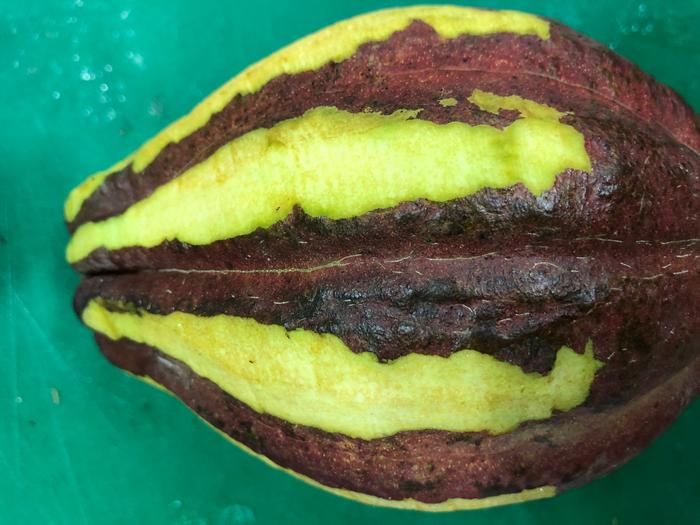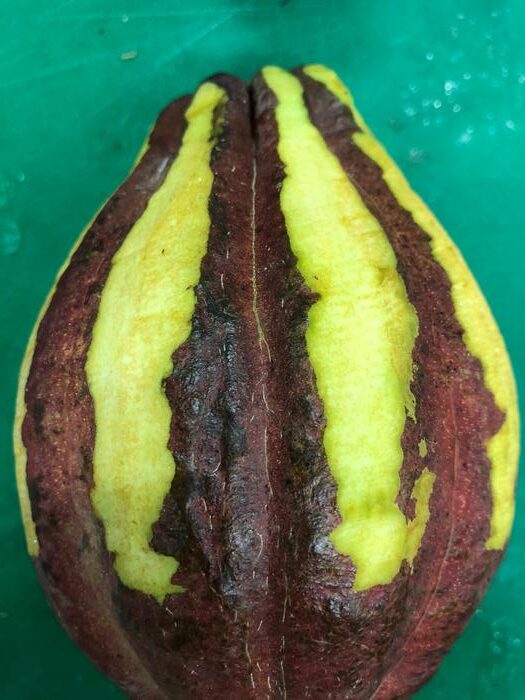As Halloween approaches, so too does the anticipation of a trick-or-treating stash filled with fun-sized chocolate candy bars. But to satisfy our collective craving for this indulgence, millions of cocoa pods are harvested annually. While the beans and pulp go to make chocolate, their husks are thrown away. Now, researchers reporting in ACS Sustainable Chemistry & Engineering show that cocoa pod husks could be a useful starting material for flame retardants.

Credit: Dimitris Charalampopoulos
As Halloween approaches, so too does the anticipation of a trick-or-treating stash filled with fun-sized chocolate candy bars. But to satisfy our collective craving for this indulgence, millions of cocoa pods are harvested annually. While the beans and pulp go to make chocolate, their husks are thrown away. Now, researchers reporting in ACS Sustainable Chemistry & Engineering show that cocoa pod husks could be a useful starting material for flame retardants.
It’s estimated that about 24 million tons of leftover cocoa pod husks are produced yearly. Waste husks have been explored as a source of carbohydrates and sugars, but they also contain lignin, a tough lipid polymer found in many woody plants. And lignin could be a renewable replacement for some substances typically derived from petroleum, such as flame retardants. While most methods to produce lignin have centered on hardwood trees, some scientists have processed other plant materials that would otherwise go to waste, such as rice husks and pomegranate peels. So, Nicholas J. Westwood and coworkers wanted to see if high-quality lignin could be extracted from cocoa pod husks and determine whether it has the potential to make valuable, practical materials.
The researchers obtained cocoa husks and milled them into a powder. After rinsing to remove fatty residues, they boiled the powdered husks in a mixture of butanol and acid, a standard lignin extraction method called the butanosolv process. They next confirmed the isolated lignin’s quality and high purity, finding no evidence of carbohydrates or other contaminants.
Then, over the course of three chemical steps, the team modified the pure lignin biopolymer to have flame-retardant properties. They attached 9,10-dihydro-9-oxa-10-phosphaphenanthrene-10-oxide, which is a fire suppressant molecule called DOPO, into the backbone of the lignin polymer. In experiments, when the modified lignin was heated, it charred — but did not burn up — a sign that it could act as a flame retardant. The researchers recognize that human safety tests are important and plan to conduct them after the next phase of testing. In the future, the researchers say they will optimize the properties of their cocoa pod husk-based flame-retardant materials.
The authors acknowledge funding from the UK Biotechnology and Biological Sciences Research Council through the Global Challenges Research Fund and for in-kind contributions from Mars Wrigley Confectionery.
The American Chemical Society (ACS) is a nonprofit organization chartered by the U.S. Congress. ACS’ mission is to advance the broader chemistry enterprise and its practitioners for the benefit of Earth and all its people. The Society is a global leader in promoting excellence in science education and providing access to chemistry-related information and research through its multiple research solutions, peer-reviewed journals, scientific conferences, eBooks and weekly news periodical Chemical & Engineering News. ACS journals are among the most cited, most trusted and most read within the scientific literature; however, ACS itself does not conduct chemical research. As a leader in scientific information solutions, its CAS division partners with global innovators to accelerate breakthroughs by curating, connecting and analyzing the world’s scientific knowledge. ACS’ main offices are in Washington, D.C., and Columbus, Ohio.
To automatically receive news releases from the American Chemical Society, contact [email protected].
Follow us: Twitter | Facebook | LinkedIn | Instagram
Journal
ACS Sustainable Chemistry & Engineering
DOI
10.1021/acssuschemeng.2c03670
Article Title
Organosolv Pretreatment of Cocoa Pod Husks: Isolation, Analysis, and Use of Lignin from an Abundant Waste Product
Article Publication Date
21-Sep-2023





